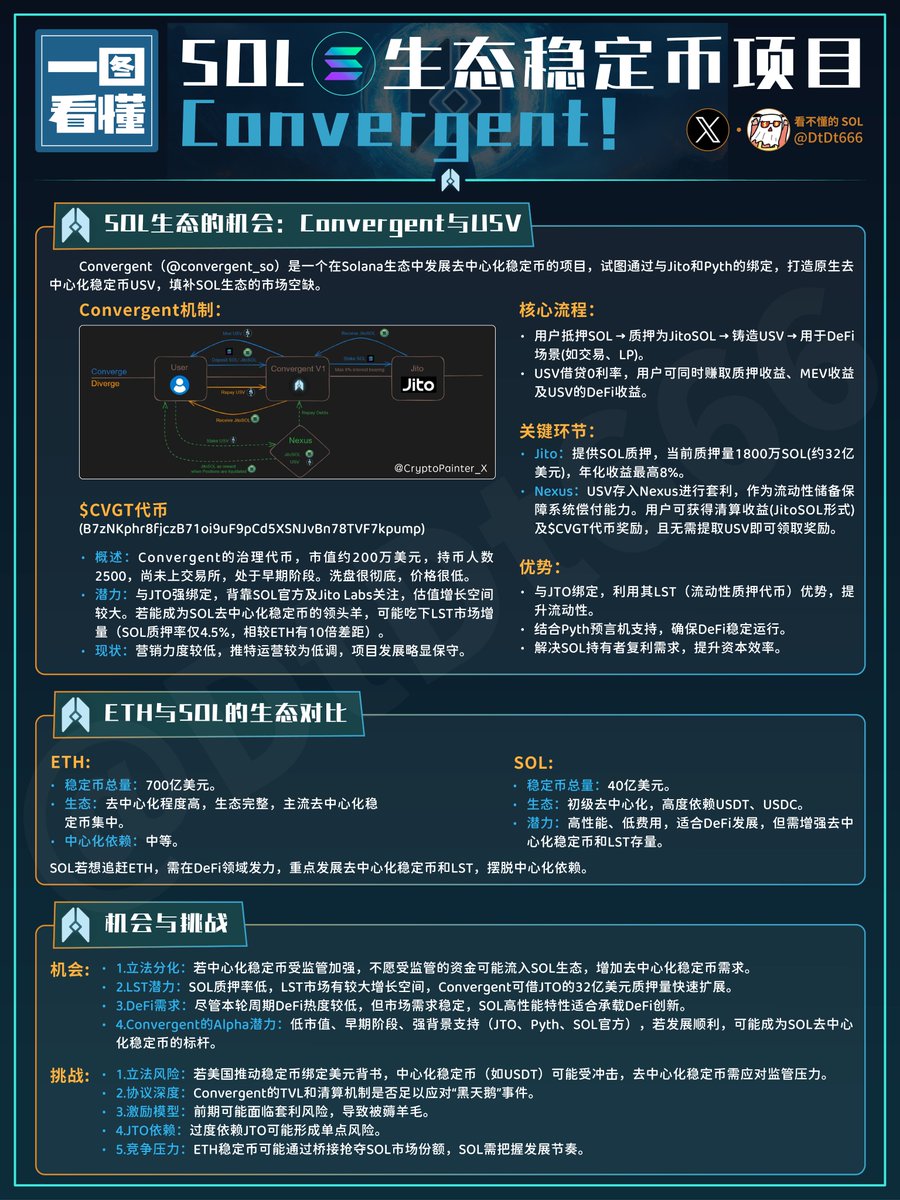What are the opportunities for the application of the US dollar stablecoin mechanism in the SOL ecosystem and the legislative context?
The US dollar stablecoin mechanism and the currency multiplier effect
The operating mechanism of stablecoins is to issue a $1 stablecoin (such as USDC) without destroying the original $1, allowing it to continue to flow in specific markets (such as the U.S. Treasury market), thereby achieving a currency multiplier effect and increasing market liquidity without triggering inflation or depreciation.
This mechanism is applied to the stablecoin USV in the Solana ecosystem, which mints USV by pledgeing SOL to improve capital efficiency by "one SOL becomes two SOL".
Users can earn income by staking SOL and use USV to participate in the DeFi ecosystem and earn additional returns.
Stablecoin legislation and the impact of the Crypto market
The United States is rapidly advancing the Stablecoin Legislation to activate the "currency rights" narrative, aiming to build it into a form of dollars in the crypto "parallel world" by controlling the issuance of stablecoins. Its core objectives include:
· Control Crypto Dollar Capital: Gain control over stablecoin issuance through legislation and compliance, guiding market asset prices.
· Expand US Dollar Liquidity: Enhance the global influence of the US dollar, prevent capital flight, and attract offshore capital.
· Short-term benefits: Legislation promotes capital flows and active markets, promoting rapid industry expansion, but we need to be vigilant against bubble risks.
The first stablecoin stock Circle (USDC issuance) U.S. stocks quadrupled in three days on the market, setting a new record for the highest three-day increase in a large IPO since 2020.
The differentiation between centralized and decentralized stablecoins
Stablecoin legislation will drive market differentiation, forming two camps:
· Centralized stablecoins: such as USDC, which are compliant, secure, and have strong endorsements, but are deeply bound to the US dollar interest system and are subject to US judicial supervision.
· Decentralized stablecoins: such as DAI, which are pegged to the US dollar but more flexible, have strong DeFi attributes, and are not subject to US regulations.
At present, decentralized stablecoins (such as DAI and LUSD) are mainly concentrated on the Ethereum (ETH) network, with a total of about $70 billion in ETH stablecoins, while Solana (SOL) is only about $4 billion, and more than 90% are centralized stablecoins such as USDT and USDC. The SOL ecosystem is less decentralized, but has great potential.
So what are the current opportunities in the SOL ecosystem?
Front-end time saw @CryptoPainter_X artists they shared a project@convergent_so This is a project to develop decentralized stablecoins in the Solana ecosystem, trying to create a native decentralized stablecoin USV through binding with Jito and Pyth to fill the market gap in the SOL ecosystem.
Convergent mechanism
· Core Process:
Users stake SOL → stake to mint USV → for JitoSOL → for DeFi scenarios (e.g., trading, LP).
USV lending has 0 interest rates, and users can earn staking income, MEV income, and USV DeFi income at the same time.
· Key links:
Jito: Provides SOL staking, with a current pledge of 18 million SOL (approximately US$3.2 billion) and an annualized return of up to 8%.
Nexus: USV is deposited into Nexus for arbitrage as a liquidity reserve to guarantee the solvency of the system. Users can receive liquidation yields (in the form of JitoSOL) and $CVGT token rewards, and can claim rewards without withdrawing USV.
· Advantage:
Bind to JTO and take advantage of its LST (Liquid Staking Token) advantages to increase liquidity.
Combined with Pyth oracle support, it ensures stable operation of DeFi.
Solve the compound interest needs of SOL holders and improve capital efficiency.
At present, this platform is the first to be issued
Convergent's Governance Token $CVGT (CA: B7zNKphr8fjczB71oi9uF9pCd5XSNJvBn78TVF7kpump)
· Overview: Convergent's governance token, with a market capitalization of about $2.5 million and 2,300 holders, has not yet been listed on the exchange, is in the early stages, and has experienced a long period of washing, and its current position can be said to be relatively ideal.
· Potential: Strongly bound to JTO, backed by SOL officials and Jito Labs, valuation growth space is large. If it can become the leader of SOL decentralized stablecoins, it may eat the increase in the LST market (the SOL pledge rate is only 4.5%, a 10-fold gap compared to ETH).
· Current situation: Marketing efforts are low, Twitter operations are relatively low-key, and project development is slightly conservative.
Ecological comparison between ETH and SOL
ETH:
Total stablecoin supply: $70 billion.
Ecology: High degree of decentralization, complete ecology, and concentration of mainstream decentralized stablecoins.
Centralized dependency: Medium.
SOL:
Total stablecoin supply: $4 billion.
Ecology: Primary decentralization, highly dependent on USDT and USDC.
Potential: High performance, low fees, suitable for DeFi development, but need to enhance the stock of decentralized stablecoins and LSTs.
If SOL wants to catch up with ETH, it needs to make efforts in the DeFi field, focusing on the development of decentralized stablecoins and LSTs to get rid of centralized dependence.
Opportunities and challenges
opportunity
· Legislative differentiation: If centralized stablecoins are strengthened under regulation, funds that do not want to be regulated may flow into the SOL ecosystem, increasing demand for decentralized stablecoins.
· LST potential: The SOL pledge rate is low, and the LST market has a lot of room for growth, and Convergent can use JTO's US$3.2 billion pledge to expand rapidly.
· DeFi demand: Although the popularity of DeFi is low in this cycle, the market demand is stable, and SOL's high-performance characteristics are suitable for carrying DeFi innovation.
· Convergent's Alpha Potential: Low market capitalization, early stage, strong background support (JTO, Pyth, SOL official), if developed smoothly, may become a benchmark for SOL decentralized stablecoins.
challenge
1. Legislative risks: If the United States promotes stablecoins to be backed by the US dollar, centralized stablecoins (such as USDT) may be impacted, and decentralized stablecoins need to deal with regulatory pressure.
2. Protocol depth: Whether Convergent's TVL and liquidation mechanism are sufficient to deal with the "black swan" event.
3. Incentive model: You may face arbitrage risks in the early stage, leading to wool being harvested.
4. JTO dependence: Over-reliance on JTO may form a single point of risk.
5. Competitive pressure: ETH stablecoins may grab SOL market share through bridging, and SOL needs to grasp the pace of development.
summary
The Stablecoin Legislation will reshape the Crypto market pattern, promote industry expansion in the short term, and observe the impact of differentiation in the long term. SOL ecosystem passed
Projects such as Convergent, with the help of infrastructure such as Jito and Pyth, are expected to fill market gaps and enhance DeFi competitiveness. As a low-cap alpha project, $CVGT has the potential for valuation growth, but it needs to deal with multiple challenges such as legislation, protocol design and competition.
In the next five to ten years, the SOL ecosystem is expected to achieve breakthroughs in the DeFi field with the advantages of high performance and low fees, and investors can pay attention to its development dynamics while maintaining vigilance against risks.
Show original
47.47K
127
The content on this page is provided by third parties. Unless otherwise stated, OKX TR is not the author of the cited article(s) and does not claim any copyright in the materials. The content is provided for informational purposes only and does not represent the views of OKX TR. It is not intended to be an endorsement of any kind and should not be considered investment advice or a solicitation to buy or sell digital assets. To the extent generative AI is utilized to provide summaries or other information, such AI generated content may be inaccurate or inconsistent. Please read the linked article for more details and information. OKX TR is not responsible for content hosted on third party sites. Digital asset holdings, including stablecoins and NFTs, involve a high degree of risk and can fluctuate greatly. You should carefully consider whether trading or holding digital assets is suitable for you in light of your financial condition.

